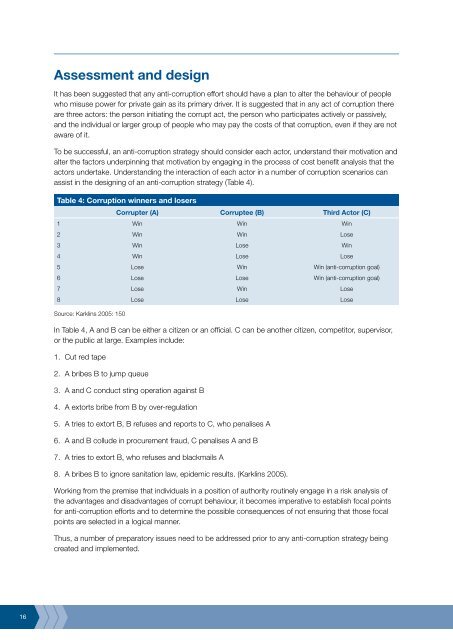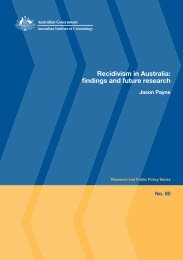Review of anti-corruption strategies Rob McCusker - Australian ...
Review of anti-corruption strategies Rob McCusker - Australian ...
Review of anti-corruption strategies Rob McCusker - Australian ...
You also want an ePaper? Increase the reach of your titles
YUMPU automatically turns print PDFs into web optimized ePapers that Google loves.
Assessment and design<br />
It has been suggested that any <strong>anti</strong>-<strong>corruption</strong> effort should have a plan to alter the behaviour <strong>of</strong> people<br />
who misuse power for private gain as its primary driver. It is suggested that in any act <strong>of</strong> <strong>corruption</strong> there<br />
are three actors: the person initiating the corrupt act, the person who participates actively or passively,<br />
and the individual or larger group <strong>of</strong> people who may pay the costs <strong>of</strong> that <strong>corruption</strong>, even if they are not<br />
aware <strong>of</strong> it.<br />
To be successful, an <strong>anti</strong>-<strong>corruption</strong> strategy should consider each actor, understand their motivation and<br />
alter the factors underpinning that motivation by engaging in the process <strong>of</strong> cost benefit analysis that the<br />
actors undertake. Understanding the interaction <strong>of</strong> each actor in a number <strong>of</strong> <strong>corruption</strong> scenarios can<br />
assist in the designing <strong>of</strong> an <strong>anti</strong>-<strong>corruption</strong> strategy (Table 4).<br />
Table 4: Corruption winners and losers<br />
Corrupter (A) Corruptee (B) Third Actor (C)<br />
1 Win Win Win<br />
2 Win Win Lose<br />
3 Win Lose Win<br />
4 Win Lose Lose<br />
5 Lose Win Win (<strong>anti</strong>-<strong>corruption</strong> goal)<br />
6 Lose Lose Win (<strong>anti</strong>-<strong>corruption</strong> goal)<br />
7 Lose Win Lose<br />
8 Lose Lose Lose<br />
Source: Karklins 2005: 150<br />
In Table 4, A and B can be either a citizen or an <strong>of</strong>ficial. C can be another citizen, competitor, supervisor,<br />
or the public at large. Examples include:<br />
1. Cut red tape<br />
2. A bribes B to jump queue<br />
3. A and C conduct sting operation against B<br />
4. A extorts bribe from B by over-regulation<br />
5. A tries to extort B, B refuses and reports to C, who penalises A<br />
6. A and B collude in procurement fraud, C penalises A and B<br />
7. A tries to extort B, who refuses and blackmails A<br />
8. A bribes B to ignore sanitation law, epidemic results. (Karklins 2005).<br />
Working from the premise that individuals in a position <strong>of</strong> authority routinely engage in a risk analysis <strong>of</strong><br />
the advantages and disadvantages <strong>of</strong> corrupt behaviour, it becomes imperative to establish focal points<br />
for <strong>anti</strong>-<strong>corruption</strong> efforts and to determine the possible consequences <strong>of</strong> not ensuring that those focal<br />
points are selected in a logical manner.<br />
Thus, a number <strong>of</strong> preparatory issues need to be addressed prior to any <strong>anti</strong>-<strong>corruption</strong> strategy being<br />
created and implemented.















